Ecological Crop Improvement For and By Farmers
Welcome to our 2025 catalog and website!
We are an organic seed farm in the Pacific Northwest, established in 1994, owned and operated by Frank and Karen Morton. We are known for farm-original varieties of many salad greens, vegetables, herbs, and flowers.
All of our seed is Organically Grown by Shoulder to Shoulder Farm
in the heart of Oregon’s Willamette Valley, a world class place to grow specialty seeds.
Few places on Earth have the climate, latitude, soil, water, and intellectual resources found in this rare north-sloping river valley. Seed companies from every continent come to the Willamette Valley to contract quality seed production. We are fortunate enough to live and farm here.
Many of these varieties originated in our on-farm breeding program for organic conditions and fresh market quality, denoted by our  farm-original farm-original  mark. Other varieties have come to us over thirty-odd years of farming, either as heirlooms or good commercial standards, now with generations of selection on the farm. All seed at risk of GMO contamination has been tested and found free of genetic engineering components. mark. Other varieties have come to us over thirty-odd years of farming, either as heirlooms or good commercial standards, now with generations of selection on the farm. All seed at risk of GMO contamination has been tested and found free of genetic engineering components.
Our ecological approach to plant breeding and crop protection generates superior varieties for farmers who don’t use chemical crop protectants and fertilizers. The small-scale care and authentic fertility of our farm fields yield fat seed with exceptional seedling vigor, a key trait for organic crop success. This seed is organically bred to be organically grown, just like your crops.
We are partners in the Open Source Seed Initiative, and have dedicated all of our original varieties and breeding populations to the Open Source Seed Pledge:
“You have the right to use these OSSI-pledged seeds in any way you choose. In return, you pledge not to restrict others’ use of these seeds or their derivatives by patents or other means, and to include this Pledge with any transfer of these seeds or their derivatives.”
New Additions for 2025
These are our new offerings for 2025. Be sure to see photos from our 2024 growing year, read Frank's essay on Working With Worms, check out all our new additions on our New Products Page, and view our Collection Of Flowers!
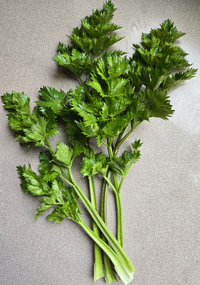
Red Featherleaf Celery
  This is an updated version of 'Red Parcel' with extra leaf dissections and longer, more tender stems. Excellent flavor as a soup celery, and beautiful presentation as a salad or garnish. We cook with celery almost every day, year-round. It’s a reliable flavor enhancer on our morning eggs, on sandwiches, in soups, or stir fries, or macaroni and cheese. Celery was once an essential cooking ingredient in American kitchens, before it became and was dissed as water in a stick. This celery here is not that. Farm Original Variety! This is an updated version of 'Red Parcel' with extra leaf dissections and longer, more tender stems. Excellent flavor as a soup celery, and beautiful presentation as a salad or garnish. We cook with celery almost every day, year-round. It’s a reliable flavor enhancer on our morning eggs, on sandwiches, in soups, or stir fries, or macaroni and cheese. Celery was once an essential cooking ingredient in American kitchens, before it became and was dissed as water in a stick. This celery here is not that. Farm Original Variety!
Pricing and More Information
| 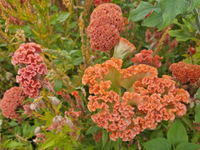
Coral Collage Celosia
These grow big crests in coral shades with branches tipped by lavender/coral spikes. A diverse mix derived from ‘Temple Bells’ x ‘Pink Flamingo’ and selected for plants with a pink-orange palette that combine traits from each. Tall plants reach 36-48” and branch without pinching, though pinching may provide longer stems for cutting.
Pricing and More Information | 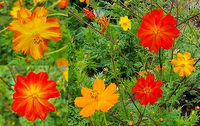
Bright Lights Cosmos
My biggest brother sent me seeds for this from his garden, somehow knowing that I have wanted to grow it for years. The 2-3” flowers are brilliant shades of orange streaked and shaded with gold and scarlet highlights on openly branching plants. I got the impression from my reading that this is a short species, around 30”, but have found that direct seeded plants easily went beyond 48” tall, while transplants averaged 36-40” tall. The leaves are fern-like and attractive, but when young, bear some superficial resemblance to ragweed (so be careful not to weed them out). Avoid very fertile conditions, as this delays flowering and can prevent it altogether. A fine cut flower (5 days in a vase), with edible petals that are also useful for natural dyeing (sometimes called Dyer’s Cosmos).
Pricing and More Information | 
Tickle Pink Cosmos
Sturdy robust plants, 48-60” tall, just covered in hot pink flowers bearing erect finger-like petals from the center as well as the expected orbit of petals around the disk. This is derived from a single volunteer plant from ‘Cupcake Mix’ that self-pollinated, apparently taking a new stable form. The extended central petals look like they were intended to tickle.
Pricing and More Information | 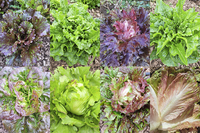
Morton's Secret Lettuce Mix 2025 Lettuce
  A wide assortment of breeding projects can be found in this year’s mix. Tom Thumb x Red Ball Jets and Crisp Mint x Red To The Heart romaines are the latest innovations here, along with 2 crisphead types with red streaking, and big “square leaf” romaines that are dressed for a clown show. There are cousins to ‘Karen’s Fave’, and some miniature leafy wavy savoyed green cos, along with deer tongue types with super wavy edges. So much genetic diversity in one packet! A snapshot of what we do for fun and innovation. Farm Original Variety! A wide assortment of breeding projects can be found in this year’s mix. Tom Thumb x Red Ball Jets and Crisp Mint x Red To The Heart romaines are the latest innovations here, along with 2 crisphead types with red streaking, and big “square leaf” romaines that are dressed for a clown show. There are cousins to ‘Karen’s Fave’, and some miniature leafy wavy savoyed green cos, along with deer tongue types with super wavy edges. So much genetic diversity in one packet! A snapshot of what we do for fun and innovation. Farm Original Variety!
Pricing and More Information
| 
Culinary Seeded Nigella
Not to be at all confused with the ornamental Nigellas (damascene, papillosa, and orientalis), the seeds of which are possibly toxic. This is the somewhat mysterious seasoning that goes by a long list of misleading names, including “black cumin” (it is not cumin, or at all related), “black caraway” (not caraway, nor related), “fennel flower’ (not!), “nutmeg flower” (no relation), “Roman coriander” (absolutely not in any sense), “black onion seed” (at least looks like it, but not), and kalonji or charnushka (which may be perfectly accurate, but are without meaning to me). The seeds of ‘Culinary Nigella’ are usually toasted or warmed to release their aromatic oils, then they may be used in breads, curries, dressings, on root vegetables, squash, and stir fry. Indian naan is often flavored with nigella, and even bagels can be topped with nigella before toasting. The plant isn’t much of an ornamental, as the petals are small, short lived, and are white to pale blue. Best to direct seed these in cool spring soil (or in autumn for mild winter zones), and thin to 12” apart. Seeds are held in sealed capsules, unlike the ornamental nigellas, which open when ripe.
Pricing and More Information | 
Amazing Grey Corn Poppy/Shirley Poppy
Unlike any other corn poppy, the unique color of this one invokes adjectives like “stormy, ominous, dramatic, moody, unmistakable, unforgettable, haunting, captivating, atmospheric, smoky, and not real” (all taken from catalog descriptions). The crepe textured grey petals are slightly suffused with other shades creating a dark palette including reds, pinks, creams, and greens. No wonder that this flower is the work of an artist. Sir Cedric Morris was a prolific British painter of portraits, landscapes, gardens, and flowers with an active career spanning over 6 decades. But equally, he was a plantsman, gardener, and breeder of flowers. His famous ‘Benton Irises,’ derived from growing out and selecting from 1000 seedling per year (over decades), are still collected today. He is credited with creating the only grey poppy ever released, bred from singular wild plants found along his hedgerows shortly after the Second World War. Perhaps this was an artist’s commentary in contrast to the red poppies of Flanders celebrated after the First World War. This poppy is sold today as ‘Amazing Grey.’
Pricing and More Information | 
Pricing and More Information | 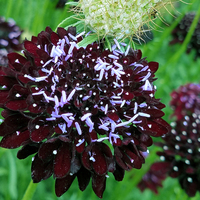
Sparky Vino Scabiosa
  This is a new selection out of ‘Deep Red,’ darker than the original shade, with a unique display of electric blue anthers that hover over the deep dark petals, held high on long sturdy stems. Farm Original Variety! This is a new selection out of ‘Deep Red,’ darker than the original shade, with a unique display of electric blue anthers that hover over the deep dark petals, held high on long sturdy stems. Farm Original Variety!
Pricing and More Information
| 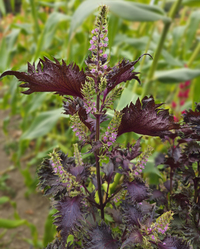
Katy's Red Japanese Shiso Perilla/Shiso
This is another garden gift from our friend, Katy Stokes (as in ‘Katy’s Picotee’ Larkspur). This is a nice selection of Red Shiso with laciniate-dentate leaves that have a rich shiso fragrance with strong notes of cinnamon. The dark purple leaves are frequently edged by shiny green teeth to beautiful effect, with the stems tipped by bright pink flowers (commonly eaten in Asia). This is the right shiso for pickling with plums and wrapping sushi. It grows to 36” in full flower, and makes a beautiful foliage plant for floral arrangements if one uses stiff mature stems (floppy stems will wilt). Naturalizes easily around the garden. Best kept from escaping the premises. Treat exactly like basil, and space seedlings 12” apart. Seed germinates easily when fresh (used for microgreens), becoming more finicky with age.
Pricing and More Information | 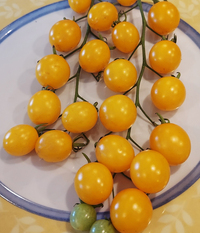
Solid Gold Cherry Tomato
When I visited my Brother-the-Doctor’s Amish-centered medical clinic recently in Belleville, Pennsylvania, a staff member took me aside to discuss some tomatoes. She said she didn’t really like tomatoes, but she liked, “These tomatoes,” and handed me a clamshell of golden cherry tomatoes. I ate a few. They were good. She said she bought them at a local supermarket. She asked if they would “come true” if she planted the seed. I said I had no idea, but there was no harm in trying… and I put one firm fruit in my pocket. We grew seed from that fruit this summer, and they “came true” for flavor and productivity in golden spades. The plants are indeterminant, early fruiting, disease resistant, heavy yielding, and uniform. I can’t find another named seed variety available on the internet that matches what we have here, so I’m calling these ‘Solid Gold’ until I learn better. They are solid for a cherry tomato, thick walled and not at all squishy. Sweet, but not overboard like a ‘Sun Gold,’ which Karen doesn’t really like. But she likes these, and we find dozens of ways to incorporate them into dishes. They are good keepers off the vine. Solid.
Pricing and More Information | |
|